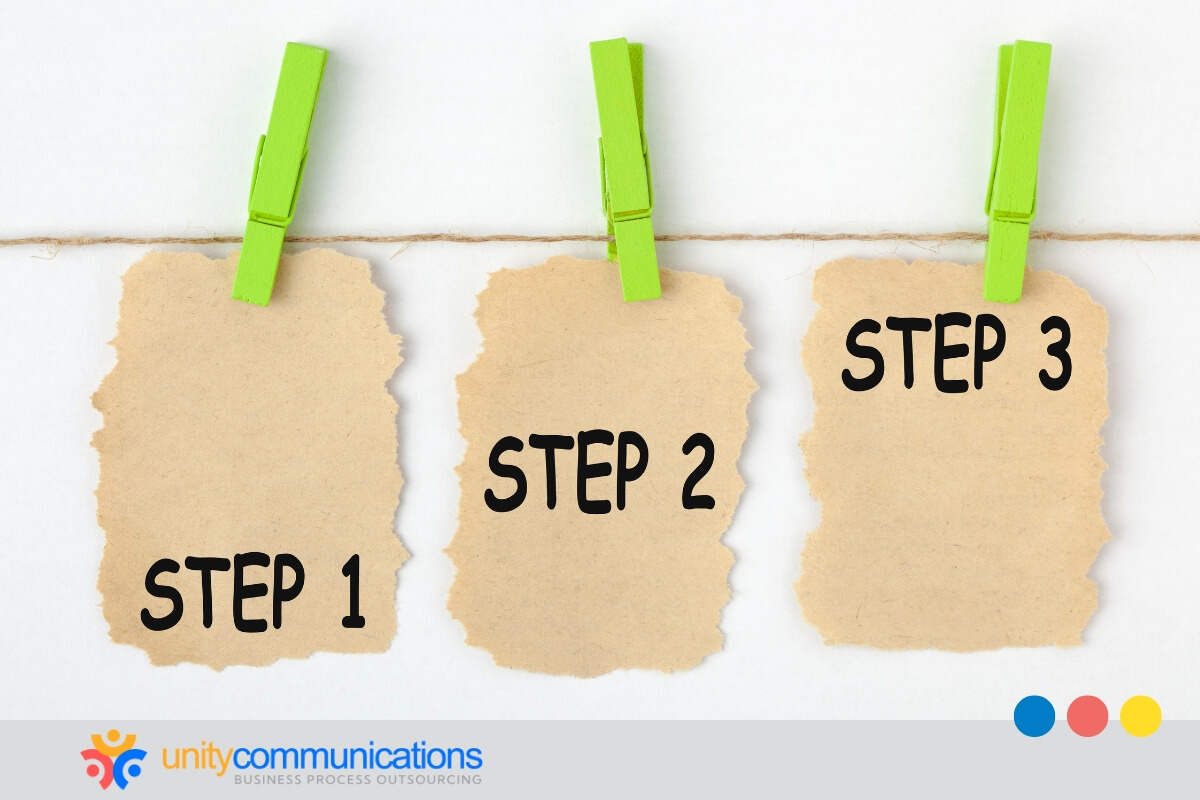Table of Contents
In today’s competitive environment, incorporating virtual assistants (VAs) into healthcare operations is becoming more common. VAs offer expertise in streamlining administrative processes and improving patient service.
This article provides a complete approach to successfully integrating virtual medical assistants into existing workflows, resulting in a smooth transition that increases productivity. It also explores the role of outsourcing in overcoming the common hurdles of VA integration.
Keep reading to learn valuable insights!
The basics of virtual assistant integration
VAs are remote professionals who support various business functions, from administrative tasks to specialized roles. In the healthcare industry, VAs can handle a range of duties, including:
- Patient scheduling to manage appointments and coordinate with medical staff
- Medical records management to organize and update patient records
- Medical billing and coding to assist with claims processing
- Customer support to assist and answer questions from patients
Unlike automated systems, VAs possess human intelligence, agility, and problem-solving abilities. Their capacity to comprehend context and complete complex tasks makes them significant assets in the healthcare sector.
Preparation for integration: Evaluating current workflows
Before incorporating VAs into operations, assess your present workflows:
- Identify recurring tasks. Look for time-consuming tasks, such as appointment scheduling or data entry.
- Evaluate workflow bottlenecks. Identify areas causing delays or inefficiencies, such as patient follow-ups or administrative paperwork.
- Determine skills gaps. Decide which activities require specific capabilities that your present team lacks, such as advanced customer support or precise medical record administration.
Considering these elements helps pinpoint areas where VAs can be most valuable, resulting in effective integration that improves overall business productivity.
Planning for integration

Thorough planning and careful consideration are necessary to engage a virtual assistant for your Phoenix healthcare organization or Chicago clinic. Follow this guide for successful VA integration:
1. Goal setting: Specify integration objectives
Establishing clear objectives is critical in VA integration to minimize misunderstandings and improve collaboration. Consider the goals listed below:
- Increased efficiency. Transfer regular duties to remote workers to simplify operations, freeing up your in-house staff to focus on strategic objectives.
- Reduced workload. Minimize the pressure on in-house employees, raising productivity and job satisfaction.
- Improved customer service. Utilize VAs for support duties to enhance response times and customer satisfaction.
2. VA selection: Choose suitable partners
Choosing the right virtual assistant is vital to successful integration. Here are some valuable tips:
- Skill matching. The VA must have experience with healthcare-specific roles, such as medical billing or patient scheduling.
- Certifications and training. Opt for a remote worker with relevant healthcare administration or medical coding certifications or training.
- References and reviews. Check endorsements and feedback to measure the VA’s reliability, performance, and professionalism.
3. Technology and tools: Support integration
Adding VAs to your organization necessitates using the appropriate technologies and infrastructure to facilitate seamless communication. Essential tools include:
- Communication tools. Platforms such as Slack or Microsoft Teams provide real-time, constant interaction and improved teamwork.
- Project management software. Trello or Asana assist with task monitoring, recording, deadline setting, and workflow management.
- Healthcare management systems. For smooth data handling, pick a VA familiar with your electronic health records (EHR) system or other healthcare management software.
These tools allow VAs to seamlessly integrate into your current systems without causing interruptions.
Step-by-step integration process

Integrating virtual assistants into existing workflows demands an organized approach to maximize their potential. Here’s a step-by-step method to merge VAs into your team and processes:
Phase one: Introduction
The initial step is to welcome a VA into your company. Give an outline of your healthcare practice, including its mission, values, and operational procedures.
Then, clearly describe the VA’s job and responsibilities so that they understand their assignments and objectives. Lastly, introduce the VA to your healthcare team, with whom they will collaborate to promote a sense of inclusion.
Phase two: Integration
This is when the VA begins to take up specific duties. Key steps include:
- Training. Provide thorough instruction on your medical practice’s processes, tools, and standards to help the VA prepare for their responsibilities.
- Task assignment. Begin by allocating modest work to the VA and gradually assigning more complicated tasks as they become more confident.
- Collaborative tools. Use interactive applications for effective communication and work management with your team.
Phase three: Optimization
Optimizing the process based on input and results is critical. Solicit input from the VA and your team to identify areas for improvement and alignment with corporate objectives.
Conduct regular assessments to evaluate the VA’s performance and team productivity. Adjust workflows in response to comments and reviews for ongoing improvement and efficiency.
Successful VA integration through outsourcing

Integrating virtual assistants into your medical firm’s existing workflows seamlessly can be achieved through business process outsourcing (BPO).
What is BPO in healthcare? This strategy entails collaborating with a third-party provider to oversee administrative work, patient interactions, and support, improving efficiency and patient care.
How outsourcing works is your BPO partner assigns competent VAs to perform the delegated tasks. This lets your internal team concentrate more on direct patient care and other vital activities.
Outsourcing administrative tasks in healthcare to third-party VAs has many benefits. It reduces overhead expenses and enhances service quality. It also allows your healthcare facility to allocate more valuable resources to improve patient services, treatment, and satisfaction.
Overcoming common challenges
Outsourcing helps your firm resolve the typical challenges of integrating virtual assistants into existing workflows. BPO organizations have the resources, infrastructure, and expertise to customize solutions specific to your concerns.
Examine common obstacles and BPO solutions:
Resistance to change
Integrating VAs into a healthcare context might elicit pushback from your in-house team, slowing the adoption process and reducing overall efficiency. To address this, consider the following strategies:
- Ensure transparent communication. Clearly describe the advantages of VAs, such as less administrative burden and more time for patient care. Provide real-world examples of how VAs improve efficiency and benefit the healthcare team. For example, let the team know how BPO experts in telemedicine effectively handle virtual consultations.
- Get your employees involved. Engage your team in the integration process by gathering feedback and addressing problems. This step helps increase a sense of collaboration and lessen resistance.
- Provide training. Offer workshops, seminars, and similar sessions to familiarize employees with the new processes and tools provided by VAs. Highlight how VAs can handle essential duties to let the staff zero in on more important obligations.
Communication barriers
Effective communication is essential when integrating virtual assistants into sensitive healthcare workflows. Here are strategies to establish clear and consistent interaction:
- Schedule frequent meetings. Set up regular check-ins to discuss progress, address pain points, and align VAs with your healthcare team.
- Utilize collaboration tools. Use platforms for real-time communication and updates, keeping everyone informed and connected.
- Keep track of the processes. Document workflows and expectations for existing employees. This minimizes misunderstandings and ensures that everyone follows the same processes.
Healthcare BPO services can also streamline communication by leveraging proven procedures explicitly created for the healthcare industry. This guarantees that VAs are effectively incorporated into current communication channels and workflows.
Security concerns
When integrating virtual assistants into healthcare workflows, maintaining data privacy and security is crucial to protecting sensitive patient information and complying with industry regulations.
Here’s how to address these concerns:
- Deploy security systems. To safeguard patient data, choose secure platforms and solutions that adhere to healthcare rules, such as the Health Insurance Portability and Accountability Act of 1996 (HIPAA).
- Provide security training. Teach VAs about data security measures and help them understand the value of maintaining confidentiality.
- Conduct regular inspections. Perform frequent audits and evaluations of security practices to detect and remedy potential weaknesses.
Outsourcing healthcare processes to BPO firms improves security. Service providers can handle sensitive data and adopt robust security measures to lower the risk of breaches and maintain regulatory compliance.
The bottom line
Working with VAs offers significant advantages to your healthcare organization, but you must carefully plan the integration to ensure success. One effective solution is leveraging outsourcing to overcome the challenges of integrating virtual assistants into existing workflows.
Your medical practice should embrace outsourcing VAs through a BPO provider to ensure seamless integration, access specialized expertise, and maintain high standards of patient care.
Let’s connect to discuss more about integrating virtual assistants into your existing workflows. Unity Communications can provide tailored solutions, support smooth VA transitions, and optimize your operations for better patient outcomes!




